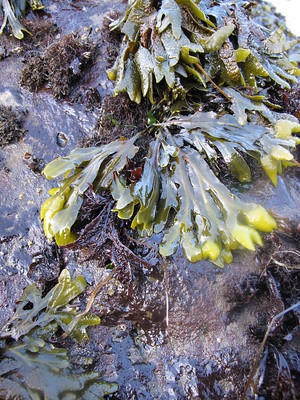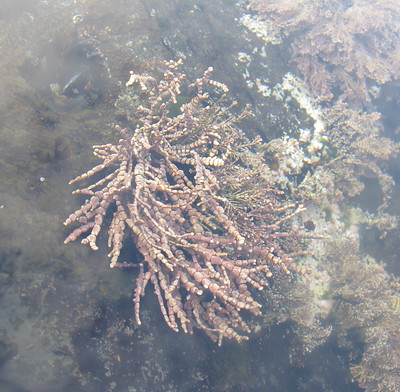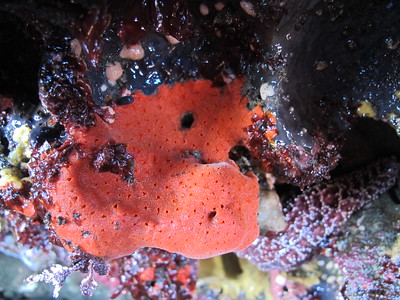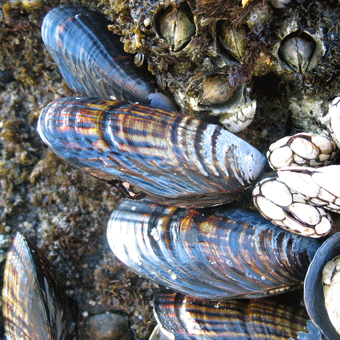Inhabitants of Oregon's Tidepools: Rockweeds
Imagine being in the water when the waves come rushing back.
 Rockweed is slippery and flexible, going “with the flow” of the water and resisting damage. But moving water can batter anything loose against anything hard, such as rocks, barnacles, or mussels: Floating up a bit may decrease the battering damage.About as wide as your thumb, only flat, the “stems” that make up rockweed are forked and forked and forked again. The ends have a pair of blunt prongs and are often puffed or inflated. Little rockweed, a different species, is about a third the size of rockweed, with the “stems” being about pencil-wide and flat. Both olive brown, rockweed grows up to perhaps ten inches long, and little rockweed grows up to almost 4 inches long.
Rockweed is slippery and flexible, going “with the flow” of the water and resisting damage. But moving water can batter anything loose against anything hard, such as rocks, barnacles, or mussels: Floating up a bit may decrease the battering damage.About as wide as your thumb, only flat, the “stems” that make up rockweed are forked and forked and forked again. The ends have a pair of blunt prongs and are often puffed or inflated. Little rockweed, a different species, is about a third the size of rockweed, with the “stems” being about pencil-wide and flat. Both olive brown, rockweed grows up to perhaps ten inches long, and little rockweed grows up to almost 4 inches long.
Rockweeds come in “male” and “female”; the tiny bumps on the inflated ends of the algae are where gametes develop.
Like other seaweeds, rockweed is habitat and food for a variety of animals: It’s best to leave them where they live.
Oregon is home to two common rockweeds: rockweed and little rockweed, shown here. Not particularly closely related, the two are most easily told apart by size (thumb-wide or pencil-wide) and by the presence of a midrib down the center of the forked branches (rockweed) or absence of a midrib down the center of the forked branches (little rockweed).
About as wide as your thumb, only flat, the “stems” that make up rockweed are forked and forked and forked again. The ends have a pair of blunt prongs and are often puffed or inflated. Little rockweed, a different species, is about a third the size of rockweed, with the “stems” being about pencil-wide and flat. Both olive brown, rockweed grows up to perhaps ten inches long, and little rockweed grows up to almost 4 inches long.
Look for limpets, periwinkles, and other life on the fronds and floats of both rockweeds.
Inhabitants of Oregon's Tidepools: Coralline Algae
This seaweed has a stony “shell.”
 Coralline algae collect calcium carbonate from the seawater, building a durable exterior. Although few can eat through or digest the mineralized outsides, densely packed coralline algae offers rich habitat for many tidepool animals. Watch for hermit crabs, snails, tidepool sculpins, and more moving among the branches of this algae.
Coralline algae collect calcium carbonate from the seawater, building a durable exterior. Although few can eat through or digest the mineralized outsides, densely packed coralline algae offers rich habitat for many tidepool animals. Watch for hermit crabs, snails, tidepool sculpins, and more moving among the branches of this algae.
Coralline algae bleaches white when it dies, making it look like even more like bits of coral or bone. Ground up by surf and moving sand, the calcium carbonate in dead algae will be dissolved in seawater and eventually reused—leaving the algae in the tidepools ensures it will be recycled.
Dusty-pink and brittle-looking, coralline algae look a lot like tufts of fine-scale coral. These seaweeds come in three different forms: flat fronds, jointed fingers, and bushy. Most coralline algae are smaller than your outstretched hand, but many of them can thickly carpet tidepools.
A close relative, pink rock crust covers rocks and shells with a bumpy, tough, dusty-pink layer, often with scalloped, bleached edges.
Inhabitants of Oregon's Tidepools: Sponges
These animals are more complicated than you might think.
 Sponges are actually colonies of one-celled individuals. There are several different types of cells in a sponge; one type has hairs that beat the water and move it though the holes of the body. Holes in the spongy layer allow water to circulate through the colony: tiny pores let water in and larger pores let water out, and canals connect the two. The individual cells feed on plankton and detritus in the water as it moves through the colony.
Sponges are actually colonies of one-celled individuals. There are several different types of cells in a sponge; one type has hairs that beat the water and move it though the holes of the body. Holes in the spongy layer allow water to circulate through the colony: tiny pores let water in and larger pores let water out, and canals connect the two. The individual cells feed on plankton and detritus in the water as it moves through the colony.
The channels and pores that circulate water through the colony also store water if the colony is exposed at low tide.
Our intertidal sponges are “encrusting,” and may grow over mussel shells and other hard surfaces, as well as over rock.
Certain nudibranchs and other grazing molluscs feed on sponges—in fact, a couple of our nudibranchs are the same color as the sponges they feed on. Look for a small, bright orange nudibranch on bright orange sponge.
Not surprisingly, our encrusting sponges are patches of slightly tough, spongy material that appears as if it were slathered on the rock and other hard surfaces, up to a quarter inch thick. The patches are irregular in shape and size, ranging from barely visible to areas larger than both your outstretched hands. Different species are different colors, with an astounding variety; different species vary in surface texture, too, from nearly-slick to rather tufted. There are tiny and larger pores in the spongy layer. In some species, such as the purple sponge in this photo, the larger pores are in the center of volcano- or nipple-shaped structures that protrude up to a quarter inch or more above the overall surface of the sponge. Some species are noted for the putrid smell they emit when crushed or rubbed.
Crawling molluscs, nudibranchs are shell-less snails that are sometimes called “sea slugs” because of their resemblance to land slugs. One of the most commonly encountered sea slugs in Oregon’s tidepools are lemon nudibranchs.
Inhabitants of Oregon's Tidepools: California Mussels

Attached to the rocks and to each other, California mussels offer different kinds of habitats.
California mussels produce a liquid adhesive from a gland opposite the hinge; a special grove in the mussel’s foot directs the adhesive to connect to something hard. Exposure to the seawater makes the adhesive solidify as the foot is retracted, and the mussel tightens down the line to keep firmly in place.
Attached together, the mussels form beds at a characteristic level in the intertidal. Many other animals and some seaweeds attach to the mussel shells, including barnacles, calcareous tubeworms, and sea palms.
Since the mussels are bluntly pointed on the bottom, there’s some space between them even when the sides are packed together. The spaces under and between the mussels are a haven for many animals, protecting them from crashing surf at high tides and drying sun at low tides, as well as protecting them from many predators.
Take care to not dislodge the mussels and expose the life beneath.
Mussels can grow so large they wedge themselves off the rock, leaving a gap in the mussel bed—too, surf-borne rocks or logs and low-tide borne people sometimes remove sections of mussel beds. It takes many years for a healthy mussel bed to become reestablished in a bald patch.

